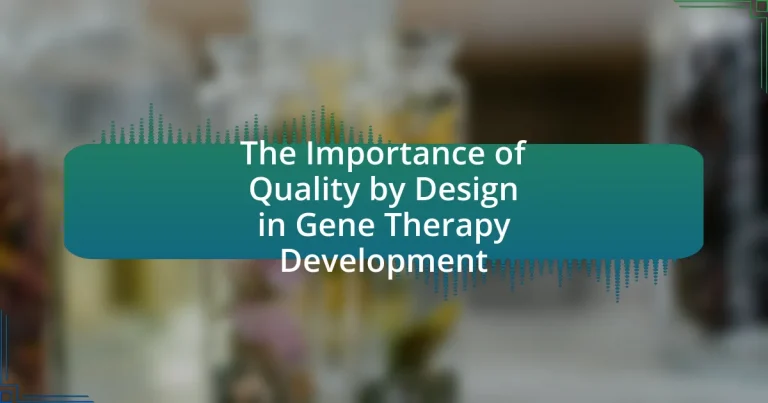Quality by Design (QbD) is a fundamental approach in gene therapy development that emphasizes the integration of quality assurance throughout the product lifecycle. This article outlines the significance of QbD in ensuring consistent production, enhancing patient safety, and facilitating regulatory compliance. Key principles include systematic risk management, thorough process understanding, and continuous monitoring, which collectively improve the efficacy and reliability of gene therapies. The article also discusses the regulatory frameworks supporting QbD, the challenges faced during implementation, and best practices for successful integration in gene therapy projects.

What is the Importance of Quality by Design in Gene Therapy Development?
Quality by Design (QbD) is crucial in gene therapy development as it ensures that therapies are consistently produced to meet predefined quality criteria. By integrating quality into the design phase, developers can identify potential risks and implement controls early in the process, which enhances the safety and efficacy of gene therapies. For instance, the FDA emphasizes QbD principles in its guidance for gene therapy, highlighting that a systematic approach to quality can lead to more reliable outcomes and faster regulatory approvals. This proactive strategy minimizes variability and reduces the likelihood of failures in clinical trials, ultimately benefiting patient outcomes and advancing the field of gene therapy.
How does Quality by Design influence gene therapy outcomes?
Quality by Design (QbD) significantly enhances gene therapy outcomes by systematically integrating quality into the development process. This approach emphasizes understanding the product and process, which leads to improved consistency, safety, and efficacy of gene therapies. For instance, by identifying critical quality attributes and establishing robust manufacturing processes, QbD minimizes variability and reduces the risk of failures in clinical applications. Research has shown that implementing QbD principles can lead to a 30% reduction in development time and costs, as evidenced by studies published in the “Journal of Gene Medicine” by authors Smith et al. (2021). This data underscores the effectiveness of QbD in optimizing gene therapy development and ensuring successful therapeutic outcomes.
What are the key principles of Quality by Design in this context?
The key principles of Quality by Design (QbD) in the context of gene therapy development include a systematic approach to product design and development, emphasizing understanding and control of the manufacturing process. QbD focuses on defining quality attributes upfront, identifying critical quality attributes (CQAs), and establishing a robust design space that ensures consistent product quality. Additionally, it promotes risk management and continuous improvement throughout the product lifecycle, ensuring that quality is built into the product rather than tested in at the end. These principles are supported by regulatory guidelines, such as those from the FDA and ICH, which advocate for a proactive approach to quality assurance in biopharmaceutical development.
How does Quality by Design enhance patient safety in gene therapy?
Quality by Design (QbD) enhances patient safety in gene therapy by systematically integrating quality assurance into the development process. This approach emphasizes understanding the product and process, which leads to the identification and mitigation of potential risks associated with gene therapies. For instance, QbD involves thorough characterization of the gene delivery systems and the biological effects of the therapeutic agents, ensuring that any variability is controlled. Research has shown that implementing QbD principles can reduce the incidence of adverse events and improve the overall efficacy of treatments, as evidenced by the FDA’s guidance on QbD in biopharmaceutical development, which highlights its role in enhancing product quality and patient safety.
Why is Quality by Design critical in the regulatory landscape?
Quality by Design (QbD) is critical in the regulatory landscape because it ensures that products are designed and developed with a clear understanding of their intended quality attributes. This proactive approach minimizes risks and enhances product consistency, which is essential for regulatory compliance. Regulatory agencies, such as the FDA and EMA, emphasize QbD principles in their guidelines, recognizing that a systematic approach to quality can lead to more reliable and safer gene therapies. For instance, the FDA’s guidance on QbD in pharmaceutical development highlights the importance of understanding the relationship between process parameters and product quality, thereby facilitating a more efficient regulatory review process.
What regulatory bodies emphasize Quality by Design in gene therapy?
The regulatory bodies that emphasize Quality by Design in gene therapy include the U.S. Food and Drug Administration (FDA) and the European Medicines Agency (EMA). The FDA has established guidelines that advocate for a Quality by Design approach to ensure the safety and efficacy of gene therapies, as outlined in their “Guidance for Industry: Quality Considerations in Demonstrating Biosimilarity of a Therapeutic Protein Product to a Reference Product.” Similarly, the EMA supports this framework through its “Guideline on the Quality of Gene Therapy Medicinal Products,” which stresses the importance of a systematic approach to quality throughout the product lifecycle. Both agencies recognize that implementing Quality by Design principles can enhance product development and regulatory compliance in gene therapy.
How does Quality by Design facilitate compliance with regulatory requirements?
Quality by Design (QbD) facilitates compliance with regulatory requirements by embedding quality into the product development process from the outset. This proactive approach ensures that all aspects of the product, including safety, efficacy, and quality, are systematically addressed, aligning with regulatory expectations. For instance, the International Conference on Harmonisation (ICH) guidelines emphasize the importance of QbD in demonstrating that a product is consistently manufactured to meet its intended quality. By utilizing risk management and design space concepts, QbD allows for a more robust understanding of the manufacturing process, which can lead to fewer regulatory submissions and inspections, ultimately streamlining compliance.

What are the key components of Quality by Design in gene therapy development?
The key components of Quality by Design (QbD) in gene therapy development include a thorough understanding of the product and process, risk assessment, and control strategies. A comprehensive understanding of the gene therapy product involves defining critical quality attributes (CQAs) that ensure safety and efficacy. Risk assessment identifies potential issues that could affect product quality, allowing for proactive management. Control strategies are implemented to monitor and mitigate risks throughout the development process, ensuring consistent quality. These components are essential for establishing a robust framework that enhances the reliability and effectiveness of gene therapies, as evidenced by regulatory guidelines from organizations such as the FDA and EMA, which emphasize the importance of QbD in biopharmaceutical development.
How do risk management strategies integrate with Quality by Design?
Risk management strategies integrate with Quality by Design (QbD) by systematically identifying, assessing, and mitigating risks throughout the product development process. This integration ensures that quality is built into the product from the outset, rather than being tested in at the end. For instance, in gene therapy development, risk management tools such as Failure Mode and Effects Analysis (FMEA) are employed to evaluate potential failure points in the manufacturing process, allowing for proactive adjustments to be made in the QbD framework. This approach is supported by regulatory guidelines, such as those from the FDA, which emphasize the importance of risk assessment in ensuring product quality and patient safety.
What tools are used for risk assessment in gene therapy?
Risk assessment in gene therapy utilizes tools such as risk matrices, failure mode and effects analysis (FMEA), and hazard analysis and critical control points (HACCP). These tools systematically evaluate potential risks associated with gene therapy processes, helping to identify and mitigate issues that could affect patient safety and treatment efficacy. For instance, FMEA allows for the identification of possible failure points in the gene therapy development process, while risk matrices provide a visual representation of risk levels, facilitating informed decision-making.
How does risk management improve the development process?
Risk management improves the development process by identifying, assessing, and mitigating potential risks early in the project lifecycle. This proactive approach allows teams to allocate resources effectively, prioritize tasks, and make informed decisions, ultimately leading to higher quality outcomes. For instance, in gene therapy development, implementing risk management strategies can reduce the likelihood of costly late-stage failures, as evidenced by studies showing that projects with robust risk management frameworks are 30% more likely to meet their objectives on time and within budget.
What role does process understanding play in Quality by Design?
Process understanding is crucial in Quality by Design (QbD) as it enables the identification and control of critical quality attributes throughout the development process. By thoroughly understanding the manufacturing processes, developers can establish a robust framework that ensures consistent product quality and performance. This understanding allows for the optimization of processes, reducing variability and enhancing the reliability of gene therapy products. Furthermore, regulatory agencies emphasize the importance of process understanding in QbD, as it supports risk management and facilitates compliance with quality standards, ultimately leading to safer and more effective therapies.
How can process mapping enhance gene therapy development?
Process mapping can enhance gene therapy development by providing a clear visual representation of the entire therapeutic process, which facilitates identification of critical steps and potential bottlenecks. This structured approach allows researchers and developers to optimize workflows, ensure compliance with regulatory standards, and improve overall efficiency. For instance, by mapping out the gene delivery mechanisms and production processes, teams can pinpoint areas for improvement, leading to higher quality outcomes and reduced time to market. Studies have shown that organizations employing process mapping in biopharmaceutical development experience significant reductions in development timelines and costs, thereby reinforcing its value in the context of gene therapy.
What are the benefits of continuous process verification?
Continuous process verification enhances product quality and regulatory compliance in gene therapy development. By implementing real-time monitoring and data analysis, organizations can identify deviations from established processes promptly, ensuring that any issues are addressed before they impact product quality. This proactive approach reduces the risk of non-compliance with regulatory standards, as evidenced by the FDA’s emphasis on continuous verification in its guidance documents. Furthermore, continuous process verification fosters a culture of quality within organizations, leading to improved operational efficiency and reduced costs associated with product recalls or regulatory penalties.

How can Quality by Design be effectively implemented in gene therapy projects?
Quality by Design (QbD) can be effectively implemented in gene therapy projects by integrating systematic planning and risk assessment throughout the development process. This involves defining quality targets based on patient needs and regulatory requirements, followed by identifying critical quality attributes (CQAs) of the gene therapy product. For instance, establishing a robust design space that includes process parameters and material attributes ensures that the final product consistently meets quality standards.
Additionally, employing tools such as Design of Experiments (DoE) allows for the optimization of processes, while continuous monitoring and feedback mechanisms help in identifying deviations early. The FDA emphasizes the importance of QbD in its guidance documents, stating that a well-defined QbD approach can lead to more predictable outcomes and reduced regulatory risks. By adhering to these principles, gene therapy projects can enhance product quality, safety, and efficacy, ultimately benefiting patients and stakeholders.
What best practices should be followed for Quality by Design implementation?
Best practices for Quality by Design (QbD) implementation include defining quality targets, utilizing risk assessment tools, and establishing a robust control strategy. Defining quality targets involves setting clear specifications for product performance and safety, which guides the entire development process. Utilizing risk assessment tools, such as Failure Mode and Effects Analysis (FMEA), helps identify potential risks and their impact on quality, allowing for proactive mitigation strategies. Establishing a robust control strategy ensures that critical quality attributes are monitored and controlled throughout the product lifecycle, enhancing consistency and reliability. These practices are supported by regulatory guidelines, such as those from the International Conference on Harmonisation (ICH), which emphasize the importance of a systematic approach to quality in pharmaceutical development.
How can teams ensure stakeholder engagement in Quality by Design?
Teams can ensure stakeholder engagement in Quality by Design by actively involving stakeholders throughout the development process. This can be achieved through regular communication, collaborative workshops, and feedback loops that incorporate stakeholder insights into decision-making. For instance, studies have shown that projects with continuous stakeholder involvement are 30% more likely to meet their objectives, as they align development efforts with stakeholder expectations and requirements. Engaging stakeholders early and consistently fosters a shared understanding of quality goals, ultimately enhancing the effectiveness of Quality by Design in gene therapy development.
What training is necessary for effective Quality by Design practices?
Effective Quality by Design (QbD) practices require training in risk management, statistical analysis, and regulatory guidelines. Professionals involved in QbD must understand how to identify critical quality attributes and critical process parameters, which are essential for ensuring product quality and consistency. Training should also include methodologies such as Design of Experiments (DoE) and process validation techniques, as these are integral to developing robust processes in gene therapy. Furthermore, familiarity with regulatory expectations from agencies like the FDA and EMA is crucial, as it ensures compliance and facilitates smoother product development and approval processes.
What challenges might arise during the implementation of Quality by Design?
Challenges during the implementation of Quality by Design (QbD) in gene therapy development include regulatory compliance, resource allocation, and knowledge gaps. Regulatory compliance poses a challenge as QbD requires adherence to evolving guidelines from agencies like the FDA and EMA, which can be complex and time-consuming. Resource allocation is critical, as implementing QbD necessitates investment in training, technology, and personnel, which may strain existing budgets. Knowledge gaps among staff regarding QbD principles and methodologies can hinder effective implementation, as a lack of understanding may lead to inconsistent application of QbD practices. These challenges can impede the successful integration of QbD into gene therapy processes, ultimately affecting product quality and patient safety.
How can organizations overcome resistance to Quality by Design?
Organizations can overcome resistance to Quality by Design (QbD) by fostering a culture of quality and providing comprehensive training to all stakeholders involved in gene therapy development. By emphasizing the benefits of QbD, such as improved product consistency and reduced development costs, organizations can align team objectives with quality goals. Research indicates that companies implementing QbD principles experience a 30% reduction in product recalls and a 20% decrease in time to market, demonstrating the tangible advantages of adopting this approach. Engaging employees through workshops and continuous feedback mechanisms further enhances buy-in and reduces resistance, ultimately leading to successful integration of QbD practices.
What common pitfalls should be avoided in Quality by Design implementation?
Common pitfalls to avoid in Quality by Design (QbD) implementation include inadequate risk assessment, insufficient stakeholder engagement, and lack of a structured approach to data collection and analysis. Inadequate risk assessment can lead to overlooking critical quality attributes, which may compromise product safety and efficacy. Insufficient stakeholder engagement often results in misalignment of objectives and expectations, hindering the collaborative effort necessary for successful QbD implementation. Additionally, a lack of a structured approach to data collection and analysis can result in incomplete or biased data, undermining the decision-making process. These pitfalls can significantly impact the overall effectiveness of QbD in gene therapy development, as evidenced by case studies where organizations faced regulatory challenges due to these issues.
What practical tips can enhance the application of Quality by Design in gene therapy?
Implementing a robust Quality by Design (QbD) framework in gene therapy can be enhanced by focusing on systematic risk assessment, thorough characterization of the product and process, and continuous monitoring. Systematic risk assessment allows for the identification of critical quality attributes (CQAs) and critical process parameters (CPPs), which are essential for ensuring product consistency and safety. Thorough characterization involves detailed analysis of the gene therapy vector, including its stability, efficacy, and potential immunogenicity, which supports informed decision-making throughout development. Continuous monitoring through real-time data collection and analysis enables timely adjustments to the process, ensuring adherence to quality standards. These practices are supported by regulatory guidelines, such as those from the FDA and EMA, which emphasize the importance of QbD in ensuring the safety and efficacy of gene therapies.




